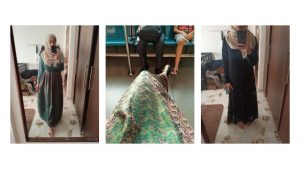
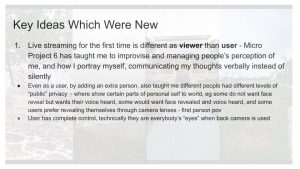
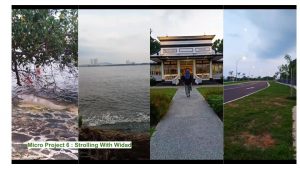
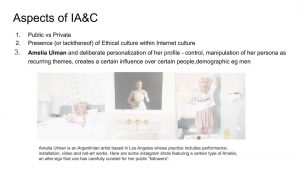
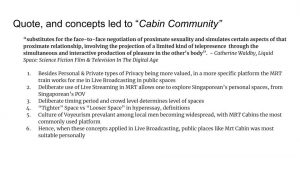
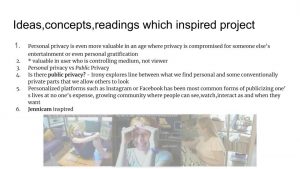
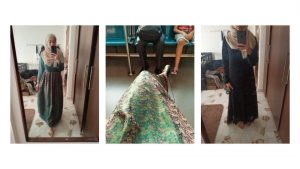
Category: DM3012- INTERNET ART & CULTURE
HYPERESSAY – The Cabin Reflects Community
As we learn to be more of sharing and “open source” society, many turn to social media to learn ways to “express ourselves”, our lifestyle, our habits, our norms to an audience. With that being said, personal privacy is even more valuable in an age where privacy is compromised for someone else’s entertainment or even personal gratification. But before anyone gets mistaken, there is nothing wrong with sharing certain parts of ourselves, it is acceptable. But it is acceptable as long as we are aware of the risks factors that come from it.
My project will revolve around a person journeys through travel in a crowded MRT train expressing certain discomforts from being in spaces which are both “tight” and “loose”. By tight meaning – a lot of people, with little space to manoeuvre, and this setting is contrasted with a more spacious space, like a “loose” envionement.
My project will allow people to see my route from school to home, with some portions of it highlighted for example, moving across cabins to avoid too much closeness with passengers, passengers looking into camera, and panning camera to see who is looking into my camera during live broadcasting.. The discontentment from having strangers stand or sit too close to you, stranger prying to look into what you are looking in your phone, and the normalized discomfort of being looked at a certain way in MRT train – I will attempt to capture that through the live broadcasting.
There would be voice overs to describe route on the way home, describe in detail how this would take place, as an added personal touch. I would consider moving to a quieter environment where the bus is “looser” as well so that this would highlight the contrast between different types of spaces experienced by an individual.
In today’s time where we can reveal private moments among friends, family and even strangers in our circle, our personal spaces or privacy is ever more valued in a time where we know, people have a reason to get into your personal business, and even feel entitled it. Whether we are in physical spaces which are tight, like in a crowded train, strangers may have a reason to stand close to you, but at the same time this could give them an opportunity to carry out human behavioural tendencies that is normally discomforting in nature.
An essay I used as reference is “Liquid Space: Science Fiction Film and Television in the Digital Age” (Waldby)where Catherine Waldby’s writings were mentioned. The author quoted
“To engage in sexualized exchange at the screen interface is to suture the body’s capacities for pleasure into the interactive space of the network, to use that network at the medium for pleasuring and being pleasured at a distance.” And “substitutes for the face-to-face negotiation of proximate sexuality and simulates certain aspects of that proximate relationship, involving the projection of a limited kind of telepresence through the simultaneous and interactive production of pleasure in the other’s body”.
The project idea may not have any provocative elements like that abovementioned but it was important to note that telepresence of someone can stimulate certain strong feelings that normally comes through physical presence of someone. And using social media, or even with online communities, it works in a way communities have traditionally thrived – which is to create spaces where shared “normals” exist. I thought this was relevant to the project idea that I am working on where voyeurism in the Singaporean community has taken to new forms – in online community spaces where exchange of photos that stimulate certain emotions to derive certain pleasures, is used as an alternative to real life, thriving social relationships.
An artwork I used as a reference is “Jennicam” where Jennifer Kay Ringley films herself performing her normal everyday routine in the presence of a live camera. What I find quite interesting is her comfort of being watched doing mundane activities. However, once she stopped doing “lifecasting”, she said she was content in living a private life too.
The main morale of this project is to also show how viewers, who are digital voyeurs themselves, would be more aware of their role, understand how this normalized trend of watching people online, may or may not have some effects to the way they view people in general. With the growing trend of voyeruism as seen in TODAY’s article (Ting, n.d.)and the project idea of valuing personal space, it also shows the growing tension between these two factors in a growing digital age we live in now.
Tight spaces, loose spaces on the Internet
Online “tight” or “loose” spaces are some elements that we can learn off of this project idea too. With “looseness” online, viewers taking in my broadcasting are given complete freedom to exercise their right over the Protagonist (me) in making comments, inviting some form of interaction from me, while I am caught in between the “tightness” of the spaces in the MRT cabin. And also, some users find a lot of liberty in exercising power through online means – where they tell people what to do, have complete freedom to watch live broadcasts without appearing creepy and etc.
With that being said, unlike “loose” spaces, when we describe internet spaces which are “tight”, it means limitations imposed on the online user. It may include inaction and passive-aggressiveness of user in being part of the live broadcasting. That affects the Protagonist in such a way, viewers can only go so far in making their intents known to the person behind the live broadcasting. I, as protagonist can choose to ignore their requests in favour of my own.
Excluding the quoted paragraph word count is 684 words
Bibliography
Ting, W. P. (n.d.). The Big Read: Singapore’s Voyeurism Problem – what’s wrong with men, or the world? . Retrieved from https://www.todayonline.com/big-read/big-read-singapores-voyeurism-problem-whats-wrong-men-or-world
Waldby, C. (n.d.). Liquid Space: Science Fiction Film and Television In the Digital Age by Sean Redmond . In S. Redmond.
Micro Project 6: Private vs Public: Strolling At Sembawang
Micro Project 6: Private vs Public
Do you see a demarcation between private and public? If yes, what are their differences? Here are some options you can consider:
For this project, I filmed as first-person live broadcaster behind the camera. This means you would not be able to see how I look like, except from my way of looking at things. In this clip, it was not planned that we were going to go to a location to do this on its own.
We had plans to go cycling and watch a movie afterwards, but decided to take our usual stroll at the park. Widad used to live near me and we would have walks together at a nearby park. Now that she has relocated to Sembawang, , she took me to her park closest to her home and took me around to introduce me her new neighborhood park.
Since this took place on Friday evening, the timing was not at the most appropriate for people to go online, and i did not inform anyone online about an upcoming broadcasting live. My friend Widad was concerned about being on a live broadcast, because of its public nature, but she was comfortable around it, eventually. I think we usually go for walks together as a way to spend time together, and in this place, Sembawang Beach – she was simply giving me/ us a tour. But I think the difference was the extra third party ( my phone recording us live) took some time for us to get used to. Eventually I thought it turned out okay.
During this recording, I also mentioned viewing this from first-person perspective – but there were limitations to this. During the walk by the sands I saw a couple seated together and kids playing by the waters, but this did not appear in the broadcasting because I wouldn’t want to be questioned. I kept it discreet.
In hindsight, I think residents there didn’t appear to concerned about my camera out. But I did not disrupt their personal – they were a couple seated by the sands watching their kids playing by the water. Just like my friend and I, we were having our own “private moment” so I didn’t feel like I should intrude on the couple’s private moment too.
The abstract moment would be the part where the lights of the lamppost is shown together with the moon during our walk back to Widad’s home. I thought the size and color of those two objects were matching – and it really did when I gave a close up shot. I thought that was beautiful!
In summary, a lot of what I have filmed were not planned out, apart from letting Widad know about this ( and then mentioning this during the live broadcast) because the context here was visiting Widad’s new place and going for our usual walk at her park nearby.
Disclaimer: During the instagram live broadcast, there was no time duration stated to show how long it has been live. It was only until I stopped recording that it recorded below the 20min mark requirement. Therefore, the video is shorter than it is suppose to be, unfortunately.
However, the second video below is a “back-up” video to make up for the extra time needed to hit the minimum duration of 20 minutes. It also featured Widad and I, just in a different environment this time – a place more private ( in a car).
In summary, the biggest learning point for me was that there will always be a clear benchmark between public and private. The part where it was mentioned where the “third-party” comes in shifted the dynamic between my friend and I while we go for our routine walk at a park. Something that was meant to be private, was out in public – which may be discomforting to some. At the same time, it could be pleasant to others. I think those who find it pleasant to watch this – would also appear to behave the same way when watching something as personal like a vlog, or a Jennicam video or any videos of that sort.
Also, even though there weren’t a lot of people watching, I would assume that as first person narrator, behind the camera, I am in control of what users can or cannot see – there fore that gives me a lot of allowance to let them see and make assumptions about the person behind the live broadcaster.
Micro Project 5
The original photo is taken during an overseas trip in KL where my team and I had breakfast at this hostel called “Mingle Hostel”. Taken last year. After jumping from one picture to another, the way we see our own faces comes blurred in a sea of glitches. The blurries of our faces takes away the focus that I have of my own face. In the bigger picture, I am able to spot a lot of shapes resembling mine – simplified into a lot of ovals with blacks surrounding them.
Week 3: Atmospheres by Peter Zumthor
“perfectly tempered feel to his built spaces is immediately communicated to viewers,residents, visitors and the immediate neighbourhood.”
“atmosphere is an aesthetic category. ”
Reading a place, becoming involved with it, working out the purpose, meaning and goal of a brief, drafting, planning and designing a piece of architecture is therefore a convoluted process that does not follow a straightforward and linear path
Zumworth’s line of thinking when it comes to architecture seems to be non-linear in fashion, where his thought processing is finding out more about the purpose of the building, the type of people who reside in it and what type of mood that it would bring to those who enter the building. Usually architecture would appear very mathematical, logical, with proper planning in place, but I guess that is also something that is just as important as the thought processes, like how Zumworth has mentioned.
Quality architecture is when a building manages to move a person
“I enter a building, see a room, and in the fraction of a second – have this feeling about it.
“emotional sensibilities – a form of perception that works incredibly quickly, and which we humans evidently need to help us survive.”
- That view of seeing is already innate in us, heightened awareness of this would make us more appreciative of how first impressions work when we come across people and buildings
- Besides appreciating, we also tend to reject things in a flash, as author described.
Compared to previous readings, the author has a very romantic perception towards buildings – by describing it as similar to how we form first impressions of people. He seems to associate it with good and bad feelings and he is very expressive in how each particular buildings makes him feel. It does point towards
The task of creating architectural atmosphere also comes down to craft and graft
The Island of The Dead Arnold Bocklin, 1880, Wendlinghausen
Swiss Sound Box, Expo 2000
Edward Hopper’s Early Sunday Morning



graft – the acquisition of money, gain or advantage by dishonest, unfair or illegal means especially through the abuse of one’ position or influence in politics and business.
Micro-Project 4: Pirate Broadcasting
This place was filmed at the bus stop right outside of the ADM Building at around 9pm last night. I decided to film the bus stop right across the road because the way the lampost lights its up was quite interesting. It also reminded me of my past work where I filmed bus stops – but the camera was directly in front of the bus stop – not at the side. The lightings at night are bring a certain mood to the whole setting of the bus stop. That is why it was filmed outside.
However, It would look better if it was filmed landscape, but that would be inconvenient for viewers to see, so had to put it in portrait.
I tried to film it still with my arms upright, but that wasn’t possible without movement. I wanted to film it still because it would take stillness of this place and this would mean moving objects – such as vehicles and people are quietly observed too…
Some passing comments from passerby walking past with their friends were school-related, some were vulgar expressions from no where so the person couldn’t be identified in the clip, and some looked curiously behind my camera when they by passed me.
The sounds of crickets could be heard,they were louder than murmers or mumblings of the people talking. The sounds of engines from motorbikes and the passing vehicles were loud but they gradually got softer after a while. The most stagnant sounds throughtout were the cricket sounds and little murmurs of people talking .
Some ideas to follow up for Final Project ( Live 1 Hr Video )
- Different stations of bus stops every 15 minutes, within the campus
- Timing of filming would be during peak periods 4pm-6pm to record unscripted dialogues among passers by and people waiting by bus stop
- Alternatively, morning + night
- Filming within campus instead of outside of campus – increase probability of me bumping into people I know (predictable dialogues – “What are you doing here? Why are you filming?” Is this for a project? ” – Have more control over the outcome of this Live Video Feed, as the person behind it, observe the dialogues in my surroundings
Write up for Micro Project 3. Together Split
Together-We-Split is a formation of a clips each of us are in – combined together. It was suppose to be “seamless” but there camera functions in the video group call did not feature same type of people across all our phones ( each individual took up a different space in each phone). We tried to join two bodies together, as if they are one; we had to bring a lot of the “pieces” together, with some difficulty. But, the improvisations were quick, because every one had to contribute something different, yet at the same time, it adds up to one piece.
This was performed in the room we had our lectures in.
Personally, I think we could have invested more time thinking through what kind of choreography we should do before executing it on video. The problem we had was the function of video call work, but the interface was different for each of our phone. So, I had to refer to Jake’s phone to see how I should adapt body parts proporly, which that in itself is tricky to work to. Had we worked in a different location, that would be even more interesting – because we would need to be more verbal about what we need to do to make our work appear seamless.
Which project did you feel you had the most creative control? Why?
The project that I felt had the most creative control was the Micro Project 2 – which was crowdsourcing art.
I was able to get quick, honest responses about the community I live in and I really liked to see how people’s views of their own community differ from their own peers (who fall under same age group) . This wouldn’t be quick and efficient without the Internet, which lends itself a powerful tool in learning about cultures we know about. At the same time, there are limitations to this because although efficient, the responses could be superficial and short. Alternatively, we could draw surveys by having dialogue sessions or focus groups, which would be more interesting but we had time constraints.
Which project did you feel you had the most unpredictable outcome? Why?
Micro-Project 3 had the most unpredictable outcome, because you have to quickly adapt yourself to a new idea or improvisation. And that requires you to think on your feet.
Which project best illustrates the concepts of Open-Source? Why?
The Crowd-sourcing best illustrates concepts of Open source because you can draw out as many responses as many times as you can, and you have a lot of control over the types of questions you can ask to different types of people. With regards to understanding people’s perceptions of their own cultures and other cultures, this does help me to learn how despite living in same communities, their perceptions vary.
The anonymity that comes from Open source has its limitations too. Despite how responses are personalized , people’s motives may be different and can result in some kind of dishonesty, which can affect the out come of my survey. While looking through responses as main “controller”, I was surprised that Pollev tracked down the names and the content of what was being said at that point of time.
Micro-Project 2 – Crowd-Sourced Art
In practice, I thought of asking social media circles about what are their own impressions about the community they identify themselves with, ethnic or nationality – wise.
3) Crowd sourced community – Malay Singaporean community/ Malaysian community
4) Concept would be to revive understanding of one’s own identity based on cultural upbringing especially in a period where many are identifying themselves as more global than they are ethnical, applies in both the real and virtual world
– important to know how we we move from one identity – ethnic – to national – global and it makes us all aware that our way of normal is different to other
5) Open ended responses, with personalized touch – user can give own personal responses with anonomity.
6) The crowd can change their intentions by saying something that is more nationalistic/ cultural
7) Avoid yes/nos answers, may feature verbal/written format, otherwise freedom, can be serious/neutral/comical
8) No yes/no answers, spoken medium is English, less than 10 seconds
Documentation
Amanda and I made the poll – which is basically to gather responses from a group of people regarding what comes to mind when they think of a certain culture. We worked on both Singaporean and Swedish culture, but my initial idea was to focus on to one of Singaporean’s subculture, which is Malay Singaporean culture – but I thought since we are both come from different parts of it would be good compromise to work on two nationalities at the same time. The responses initially had to come from non-locals – so we could learn what are first impressions of a culture from an outsider’s point of view.
Eventually, since our immediate social media circles were own respective locals, we decided to make the responses coming from both Singaporeans and Swedish.
This works takes place in Facebook and Instagram for me -links were sent to them through private messaging. The work did not ask for much social interaction apart for accessibility to the poll ( there was a limits, only 25 allowed)
For my part, I asked Singaporeans on their impressions on Swedish culture, and for Amanda’s part, she asked Swedish people on their impressions on Singaporean culture.
Personal responses/Feedback From Sent Links


I had to do the significantly the same surveys twice because it took me some time to learn how to use it from a presenter’s point of view. The responders could choose to remain anonymous throughout the survey. Their names and what they types could be tracked, actually.

The survey above was done by 25 respondants, who were Singaporean. Their names and what they said could be viewed by me. The reason to do this strictly for Singaporeans was to see if there is a common perception locals view of themselves.It would be different from non-locals’ perceptions point of view.
The most common ones were “kiasu”, “hawker centres” and “food”.
Overall, I think the responses were quite interesting. If I were to do it again, I think it would be more specific towards Singaporean subcultures – chinese,malay and indians or eurasians. It would also be intersting to see the common perceptions made of other groups of people or what they view of their own communities that locals identify themselves with . The only limitation is that number of responses which is at 25. However, we could do multiple rounds to make more room for more responses.
Micro Project 0. Displacement on The Networked Space
If the images cannot be seen in the link above, here they are.
This is a series of photos that is a first-hand experience of the way I move to this hidden spot in this ADM building. The hidden spot is often a place not a lot of people dare to visit, because there’s no point taking the emergency staircase when there’s a lift outside and open staircases where you are in view of everybody in the building.
This place is a prayer area for Muslim students to pray. It is actually a make-shift one, that means past students who came here probably came up with the idea of laying out a plastic mat, bought some prayer rugs and all other essentials to make this space specially catered to anyone who would wish to perform their daily prayers during their time in school. And eventually, due to word of mouth, more and more students manage to find a good space to perform their daily rituals with essentials.
I used multiple pictures to show from first person’s point of view, how to naviagte through this hidden space – where you open two doors, climb up staircases and find this space. It is probably not known to many, except a small minority of us in the ADM community – and this ironically, is a hidden space that only is not so much of a secret anymore to some of us.






























